Мир М.Афзал Атлас клинического диагноза
Подождите немного. Документ загружается.

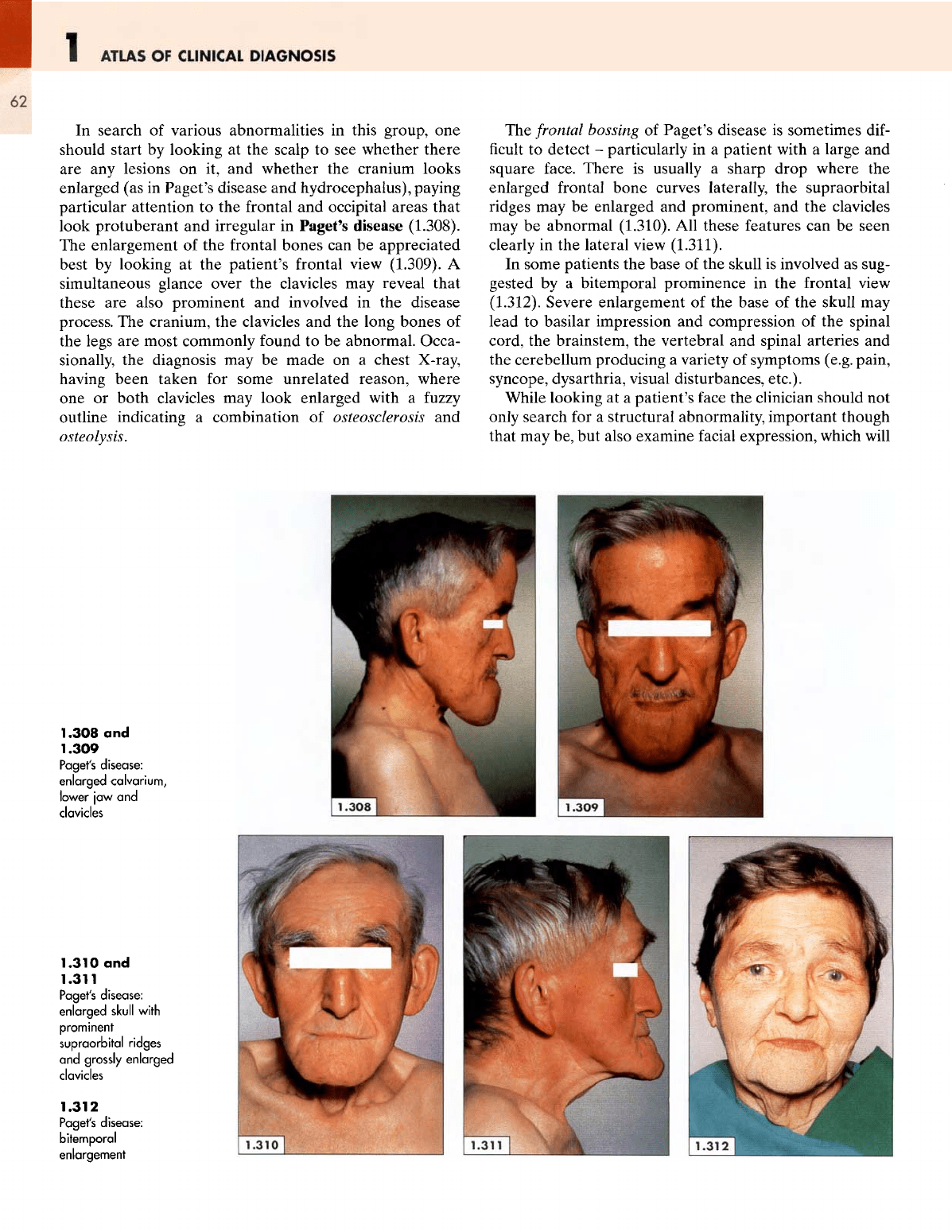
1
ATLAS
OF
CLINICAL
DIAGNOSIS
62
In
search
of
various abnormalities
in
this group,
one
should start
by
looking
at the
scalp
to see
whether there
are any
lesions
on it, and
whether
the
cranium looks
enlarged
(as in
Paget's
disease
and
hydrocephalus), paying
particular
attention
to the
frontal
and
occipital areas that
look protuberant
and
irregular
in
Paget's disease (1.308).
The
enlargement
of the
frontal
bones
can be
appreciated
best
by
looking
at the
patient's
frontal
view (1.309).
A
simultaneous glance over
the
clavicles
may
reveal that
these
are
also prominent
and
involved
in the
disease
process.
The
cranium,
the
clavicles
and the
long bones
of
the
legs
are
most commonly found
to be
abnormal. Occa-
sionally,
the
diagnosis
may be
made
on a
chest X-ray,
having
been taken
for
some unrelated reason, where
one or
both clavicles
may
look enlarged with
a
fuzzy
outline indicating
a
combination
of
osteosclerosis
and
osteolysis.
The
frontal bossing
of
Paget's
disease
is
sometimes dif-
ficult
to
detect
-
particularly
in a
patient
with
a
large
and
square
face.
There
is
usually
a
sharp drop where
the
enlarged
frontal
bone curves laterally,
the
supraorbital
ridges
may be
enlarged
and
prominent,
and the
clavicles
may
be
abnormal
(1.310).
All
these features
can be
seen
clearly
in the
lateral view
(1.311).
In
some patients
the
base
of the
skull
is
involved
as
sug-
gested
by a
bitemporal prominence
in the
frontal
view
(1.312).
Severe enlargement
of the
base
of the
skull
may
lead
to
basilar impression
and
compression
of the
spinal
cord,
the
brainstem,
the
vertebral
and
spinal arteries
and
the
cerebellum producing
a
variety
of
symptoms (e.g. pain,
syncope, dysarthria, visual disturbances, etc.).
While
looking
at a
patient's
face
the
clinician should
not
only
search
for a
structural abnormality, important though
that
may be, but
also examine
facial
expression, which
will
1.308
and
1.309
Paget's
disease:
enlarged
calvarium,
lower
jaw and
clavicles
1.310
and
1.311
Paget's
disease:
enlarged
skull
with
prominent
supraorbital
ridges
and
grossly
enlarged
clavicles
1.312
Paget's
disease:
bitemporal
enlargement
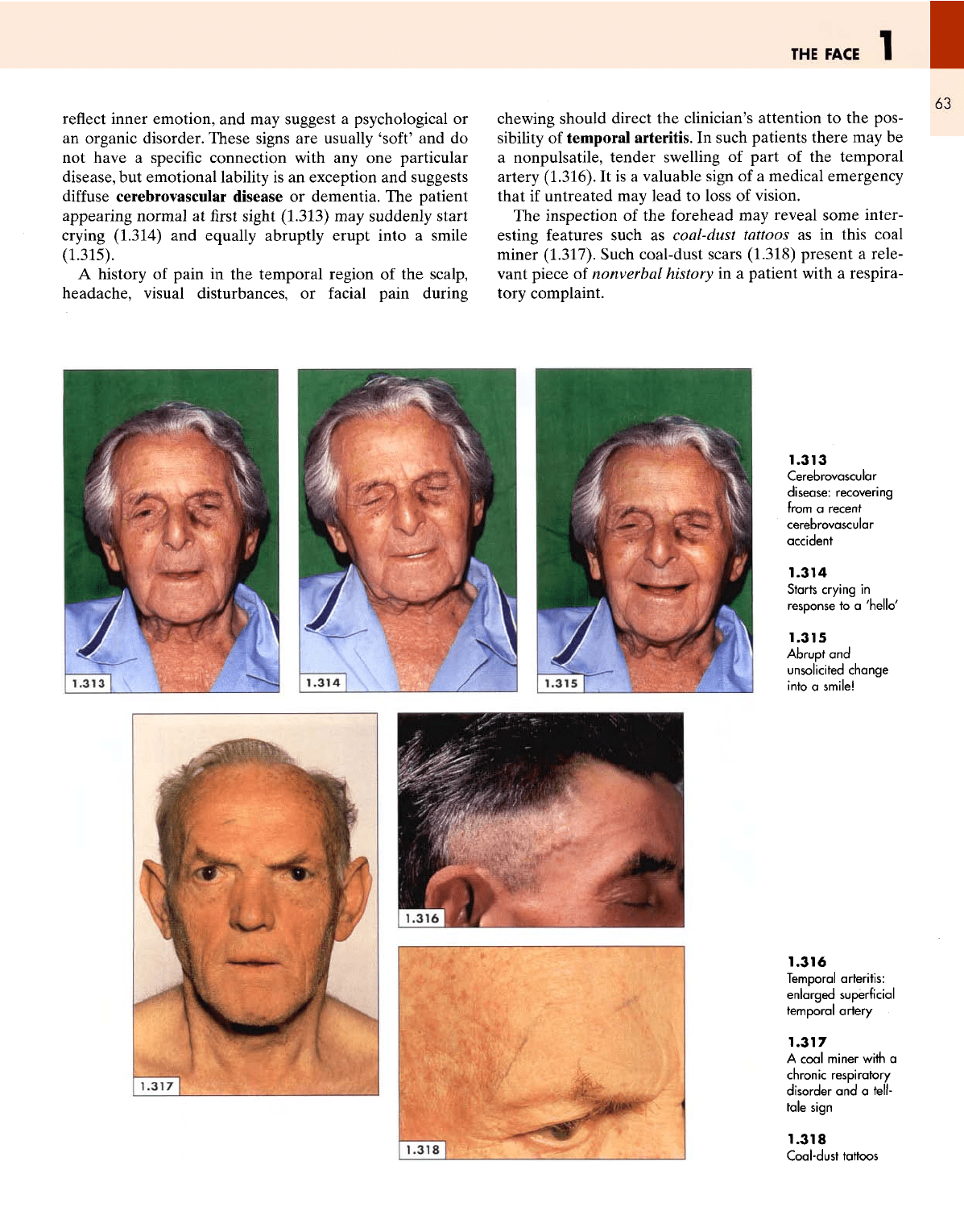
THE
FACE
1
63
reflect
inner emotion,
and may
suggest
a
psychological
or
an
organic disorder. These signs
are
usually
'soft'
and do
not
have
a
specific
connection with
any one
particular
disease,
but
emotional lability
is an
exception
and
suggests
diffuse
cerebrovascular disease
or
dementia.
The
patient
appearing normal
at first
sight
(1.313)
may
suddenly
start
crying
(1.314)
and
equally abruptly erupt into
a
smile
(1.315).
A
history
of
pain
in the
temporal region
of the
scalp,
headache, visual disturbances,
or
facial
pain during
chewing
should direct
the
clinician's attention
to the
pos-
sibility
of
temporal arteritis.
In
such patients there
may be
a
nonpulsatile, tender swelling
of
part
of the
temporal
artery
(1.316).
It is a
valuable sign
of a
medical emergency
that
if
untreated
may
lead
to
loss
of
vision.
The
inspection
of the
forehead
may
reveal
some
inter-
esting features such
as
coal-dust tattoos
as in
this coal
miner
(1.317).
Such coal-dust scars
(1.318)
present
a
rele-
vant
piece
of
nonverbal history
in a
patient with
a
respira-
tory
complaint.
1.313
Cerebrovascular
disease: recovering
from
a
recent
cerebrovascular
accident
1.314
Starts
crying
in
response
to a
'hello'
1.315
Abrupt
and
unsolicited change
into
a
smile!
1.316
Temporal arteritis:
enlarged
superficial
temporal
artery
1.317
A
coal miner
with
a
chronic
respiratory
disorder
and a
tell-
tale sign
1.318
Coal-dust tattoos
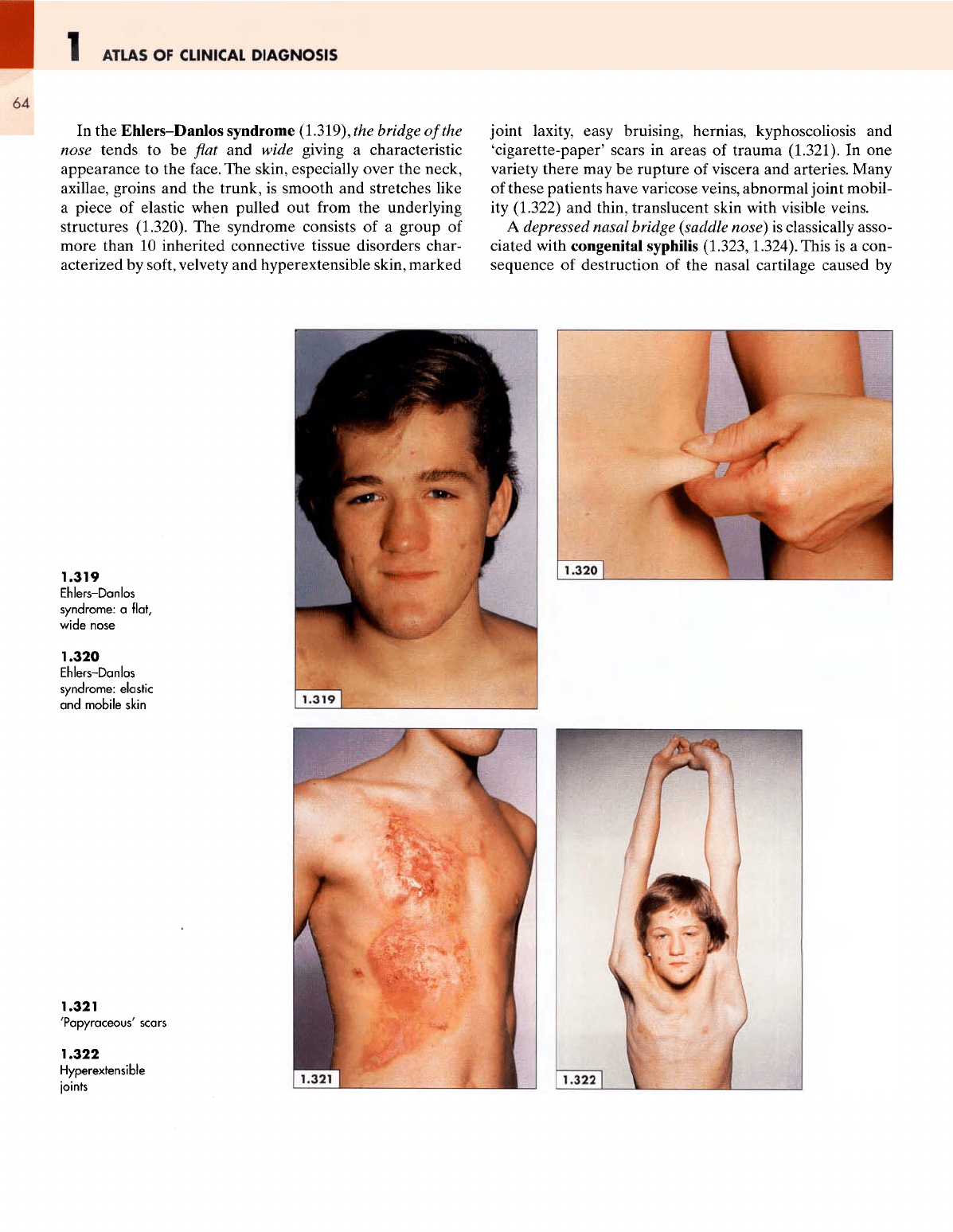
1
ATLAS
OF
CLINICAL
DIAGNOSIS
64
In
the
Ehlers-Danlos
syndrome
(1.319),
the
bridge
of
the
nose tends
to be flat and
wide giving
a
characteristic
appearance
to the
face.
The
skin, especially over
the
neck,
axillae,
groins
and the
trunk,
is
smooth
and
stretches like
a
piece
of
elastic when pulled
out
from
the
underlying
structures (1.320).
The
syndrome consists
of a
group
of
more than
10
inherited connective tissue disorders char-
acterized
by
soft,
velvety
and
hyperextensible skin, marked
joint
laxity, easy bruising, hernias, kyphoscoliosis
and
'cigarette-paper'
scars
in
areas
of
trauma
(1.321).
In one
variety
there
may be
rupture
of
viscera
and
arteries. Many
of
these patients have varicose veins, abnormal joint mobil-
ity
(1.322)
and
thin, translucent skin with visible veins.
A
depressed
nasal bridge
(saddle
nose)
is
classically asso-
ciated with congenital syphilis
(1.323,1.324).
This
is a
con-
sequence
of
destruction
of the
nasal cartilage caused
by
1.319
Ehlers-Danlos
syndrome:
a
flat,
wide
nose
1.320
Ehlers-Danlos
syndrome: elastic
and
mobile
skin
1.321
'Papyraceous'
scars
1.322
Hyperextensible
joints
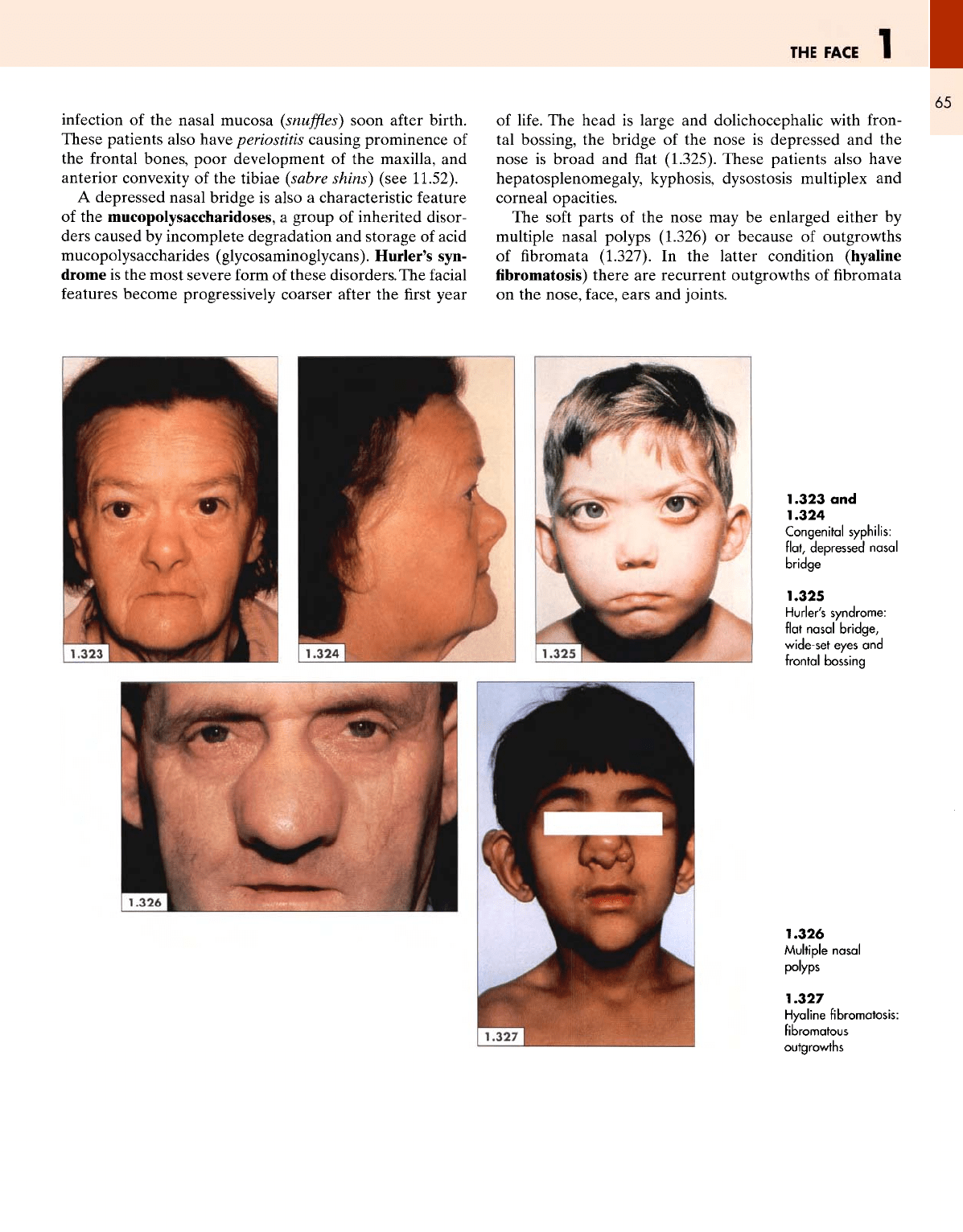
THE
FACE
1
65
infection
of the
nasal mucosa
(snuffles}
soon
after
birth.
These
patients also have periostitis causing prominence
of
the
frontal
bones,
poor
development
of the
maxilla,
and
anterior convexity
of the
tibiae
(sabre
shins)
(see
11.52).
A
depressed nasal bridge
is
also
a
characteristic
feature
of
the
mucopolysaccharidoses,
a
group
of
inherited disor-
ders caused
by
incomplete degradation
and
storage
of
acid
mucopolysaccharides (glycosaminoglycans).
Hurler's
syn-
drome
is the
most severe
form
of
these disorders.
The
facial
features
become
progressively coarser
after
the first
year
of
life.
The
head
is
large
and
dolichocephalic with
fron-
tal
bossing,
the
bridge
of the
nose
is
depressed
and the
nose
is
broad
and flat
(1.325). These patients also have
hepatosplenomegaly, kyphosis, dysostosis multiplex
and
corneal opacities.
The
soft
parts
of the
nose
may be
enlarged either
by
multiple
nasal polyps (1.326)
or
because
of
outgrowths
of
fibromata
(1.327).
In the
latter condition (hyaline
fibromatosis)
there
are
recurrent outgrowths
of fibromata
on the
nose,
face,
ears
and
joints.
1.323
and
1.324
Congenital
syphilis:
flat,
depressed nasal
bridge
1.325
Hurler's
syndrome:
flat
nasal
bridge,
wide-set
eyes
and
frontal
bossing
1.326
Multiple
nasal
polyps
1.327
Hyaline
fibromatosis:
fibromatous
outgrowths
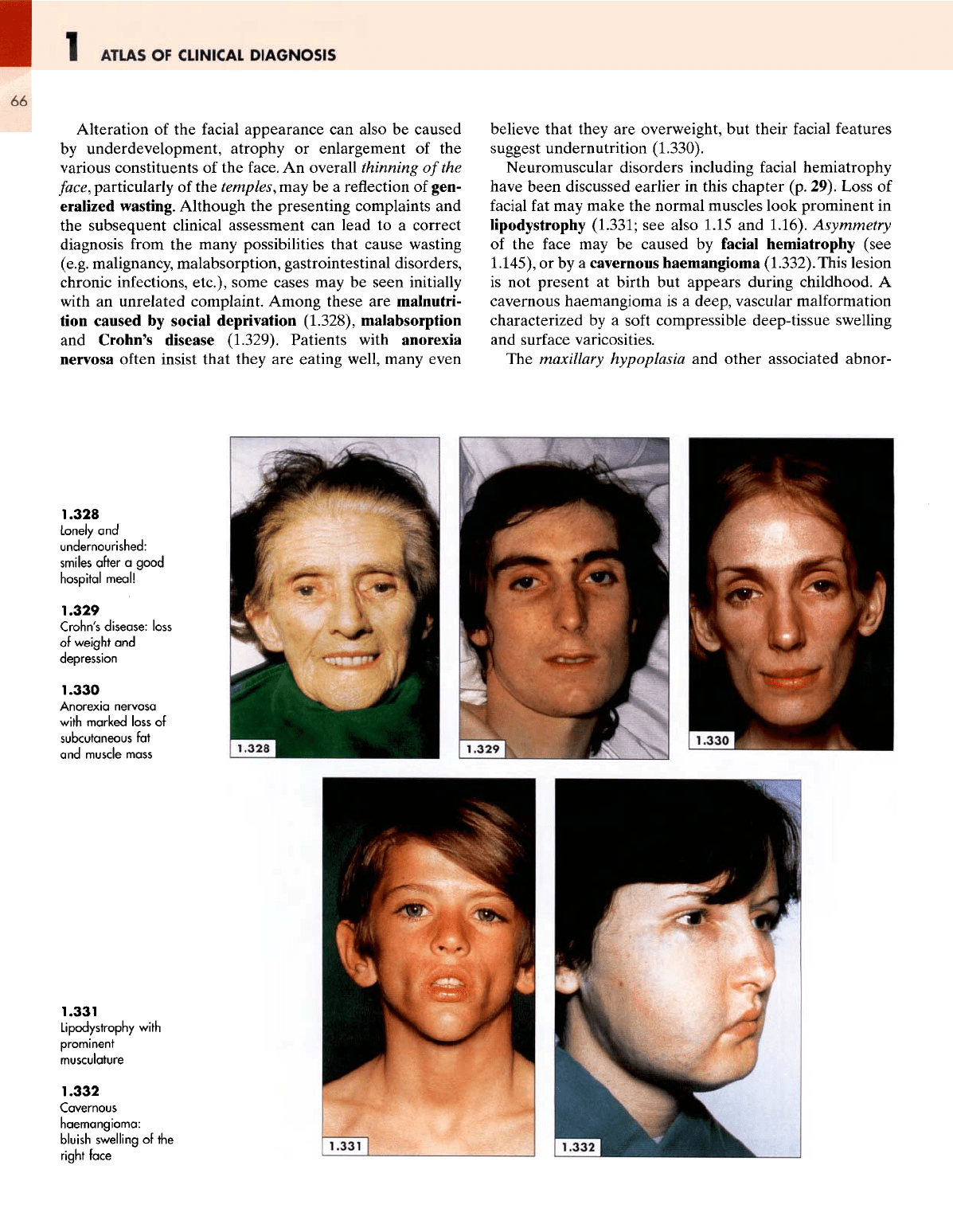
1
ATLAS
OF
CLINICAL
DIAGNOSIS
66
Alteration
of the
facial
appearance
can
also
be
caused
by
underdevelopment, atrophy
or
enlargement
of the
various
constituents
of the
face.
An
overall thinning
of the
face,
particularly
of the
temples,
may be a
reflection
of
gen-
eralized
wasting. Although
the
presenting complaints
and
the
subsequent clinical assessment
can
lead
to a
correct
diagnosis
from
the
many possibilities that cause wasting
(e.g.
malignancy, malabsorption, gastrointestinal disorders,
chronic infections, etc.), some cases
may be
seen initially
with
an
unrelated complaint. Among
these
are
malnutri-
tion caused
by
social
deprivation
(1.328), malabsorption
and
Crohn's disease (1.329). Patients with anorexia
nervosa
often insist that they
are
eating well, many even
believe that they
are
overweight,
but
their
facial
features
suggest
undernutrition (1.330).
Neuromuscular disorders including
facial
hemiatrophy
have
been
discussed
earlier
in
this
chapter
(p.
29).
Loss
of
facial
fat may
make
the
normal muscles look prominent
in
lipodystrophy
(1.331;
see
also 1.15
and
1.16).
Asymmetry
of
the
face
may be
caused
by
facial hemiatrophy (see
1.145),
or by a
cavernous
haemangioma
(1.332).This
lesion
is
not
present
at
birth
but
appears during childhood.
A
cavernous haemangioma
is a
deep,
vascular malformation
characterized
by a
soft
compressible deep-tissue swelling
and
surface varicosities.
The
maxillary hypoplasia
and
other associated abnor-
1.328
Lonely
and
undernourished:
smiles
after
a
good
hospital meal!
1.329
Crohn's disease:
loss
of
weight
and
depression
1.330
Anorexia
nervosa
with
marked
loss
of
subcutaneous
fat
and
muscle
mass
1.331
Lipodystrophy
with
prominent
musculature
1.332
Cavernous
haemangioma:
bluish swelling
of the
right
face

THE
FACE
1
67
malities
of the
Treacher Collins syndrome
(mandibu-
lofacial
dysostosis)
can
produce
a
characteristic facial
appearance with sunken cheek bones, receding chin
(mandibular hypoplasia), colobomas
of the
lower eyelids,
downward
pointing palpebral
fissures,
deformed pinnas
and
auditory canals (1.333).
The
condition
can be
diag-
nosed usually
at
birth,
and
certainly
in
early
infancy,
since
there
may be
mandibular hypoplasia with
a
tapering chin,
a
blind
fistula
between
the
angle
of the
mouth
and the ear
(1.334),
or a
deformity
of the
eyelids
and
ears. Early diag-
nosis
and the
recognition
of an
associated
conductive
hearing loss
are
important
to
prevent
the
possible delayed
learning
and
retardation
caused
by
deafness.
Even though
the
bulk
of the
muscles,
fat and
bones
in
the
face
may be
normal,
the
rigidity
of the
muscles
in
Parkinson's disease
may
give
the
face
an
abnormal mask-
like appearance (1.335). Evidence
of
poor
muscular mobil-
ity,
although
often
subtle
in the
early stages,
can be
seen
when
a
patient tries
to
smile (1.336).
Enlargement
of the
parotid gland alters
the
facial
appearance even though
at
times
the
change
may not
be
very obvious, since
the
bulk
of the
gland lies below
1.333
Treacher
Collins
syndrome:
maxillary
hypoplasia,
downward-pointing
palpebral
fissures
and
colobomas
of
lower
eyelids
1.334
Treacher
Collins
syndrome:
mandibular
hypoplasia,
blind
fistula
and
deformed
1.335
Parkinson's
disease:
mask-like facies
1.336
Poorly
mobile
facial
musculature

ATLAS
OF
CLINICAL
DIAGNOSIS
68
and
behind
the
ear,
and the
swelling
may be
only
minimal
(1.337). Mumps
is the
commonest cause
of
bilateral
or
unilateral enlargement
of the
parotid gland
in
children (1.338). Occasionally,
it
occurs
in
adults
and
may
be
complicated
by
oopheritis, epididymo-orchitis,
meningitis
and
pancreatitis. Meningitis
is a
frequent com-
plication
in
children
but
usually resolves without
any
sequelae.
The
parotid glands
are
also enlarged
in
portal cirrhosis
(especially
of
alcoholic origin), Sjogren's syndrome (1.339)
and
when involved
in a
neoplastic process.
In
Sjogren's
syndrome
the
patient
is
usually female (with
a
female:
male
ratio
of
10:1)
and may
have
the
sicca complex with
dry
eyes
and dry
mouth.
The
parotid glands
are
diffusely
enlarged
(1.340)
and
sometimes there
may be
swelling
of
the
submandibular (1.341)
and
lacrimal glands.
If
only
a
part
of the
gland
is
enlarged then
it is
more likely
to be
neoplastic (1.342).
1.337
Parotid
swelling
1.338
Mumps:
unilateral
parotid
swelling
1.339
Sjogren's
syndrome
with
bilateral
parotid
swelling
1.340
Diffuse
parotid
swelling causing
a
hollow
anteriorly
1.341
Sjogren's
syndrome
with
submandibular
gland
enlargement
1.342
Malignant
tumour
of
the
parotid
gland

2
THE
MOUTH
69
The
mouth should
be
inspected with
the
patient facing
a
good natural source
of
light. This
is
particularly important
when
looking
for
cyanosis, pallor
and
excessive redness
of
the
lips, gums, tongue
and the
buccal mucosa.
The
various
individual
components
of the
oropharynx should
be
exam-
ined sequentially.
The
lips
An
acute inflammation
of the
lips with
painful
fissuring
and
scaling (cheilitis)
at the
angles
of the
mouth (angular
cheilitis,
angular stomatitis)
(2.1)
is
usually
the
result
of
physical
damage
to the
lips
by
sunlight
or
cold wind.
In
patients with
ill-fitting
dentures,
the
skin
and the
mucosa
at
the
corners
of the
mouth become macerated because
of
dribbling
saliva, which causes
fissuring of the
angles
of the
mouth,
or
cheilosis (2.2).
It is
also
a
feature
of
deficiency
of
the
vitamin
B
complex,
especially
of
riboflavin
(2.3).
Angular
cheilosis
is
sometimes complicated
by
monilial
infection,
particularly
in
immunocompromised states.
Angular stomatitis
may
also
be
self-induced,
as in
this
patient
(2.4)
who
produced recurrent ulcers
by
digging
his
nails
into
the
angles
of his
mouth.
By
far the
commonest infection
of the
lips
is
herpes
simplex,
which
may
start
as a
simple vesicle (2.5), later
producing
a
cluster
of
vesicles
and
extending
to the
mucosa with ulceration (2.6).
The
infection
may
occur
in
healthy
but
susceptible subjects
and it is
often seen
in
asso-
ciation with
the
common cold
and
other
acute febrile states
such
as
pneumococcal pneumonia.
The
lips
may
also
be
2.1
Angular
cheilitis
2.2
Angular
fissuring
caused
by
dribbling
saliva
2.3
Angular
cheilitis:
vitamin
deficiency
2.4
Intractable
self-
induced
ulcer
2.5
Herpes simplex:
an
intact vesicle
2.6
Herpes simplex:
mucosal
ulceration

ATLAS
OF
CLINICAL
DIAGNOSIS
70
involved
in
other cutaneous infections;
for
example
in
tinea corporis they have sharply marginated,
red
plaques
(2-7).
A
primary syphilitic chancre
is a
painless nodule that
can
ulcerate
but it is
rarely seen today.
More
commonly
one
may
see a
simple wart (2.8).
A
cavernous haemangioma
is
a
bluish, compressible nodule that
may
occur
on the
lips (2.9). Both these lesions should
be
differentiated
from
a
squamous cell carcinoma, which
may
start
as a
warty,
crusted ulcer.
The
granulomatous process
of
Crohn's disease
may
involve
any
part
of the
alimentary tract
from
the
lips
to
the
anus.
Oral
lesions have been reported
in
6-20%
of
patients; these occur more commonly
in
patients with
colonic disease,
and in
those
who
have other extraintesti-
nal
manifestations such
as
joint
and
skin lesions. Oral
lesions
may
precede
the
onset
of
intestinal disease, thus
the
condition should
be
suspected
in any
patient presenting
with
swollen lips (2.10,
2.11).
Either
of the
lips
may be
involved with submucosal inflammation, oedema
and fis-
suring,
sometimes complicated
by
superadded cheilosis
and
ulceration (2.12).
Aphthous
ulcers
and
hyperplasia
of
the
cheeks with
fissuring of the
buccal mucosa
(2.13)
may
occur
in
some patients.
2.7
Tinea
corporis:
spreading
erythematous
ring
2.8
Simple
wart
2.9
Cavernous
haemangioma
2.10
Crohn's
disease
with
granulomatous
infiltration
of the
lower
lip
2.11
Crohn's disease lips
2.12
Crohn's disease:
swollen lips
with
fissures
and
angular
stomatitis
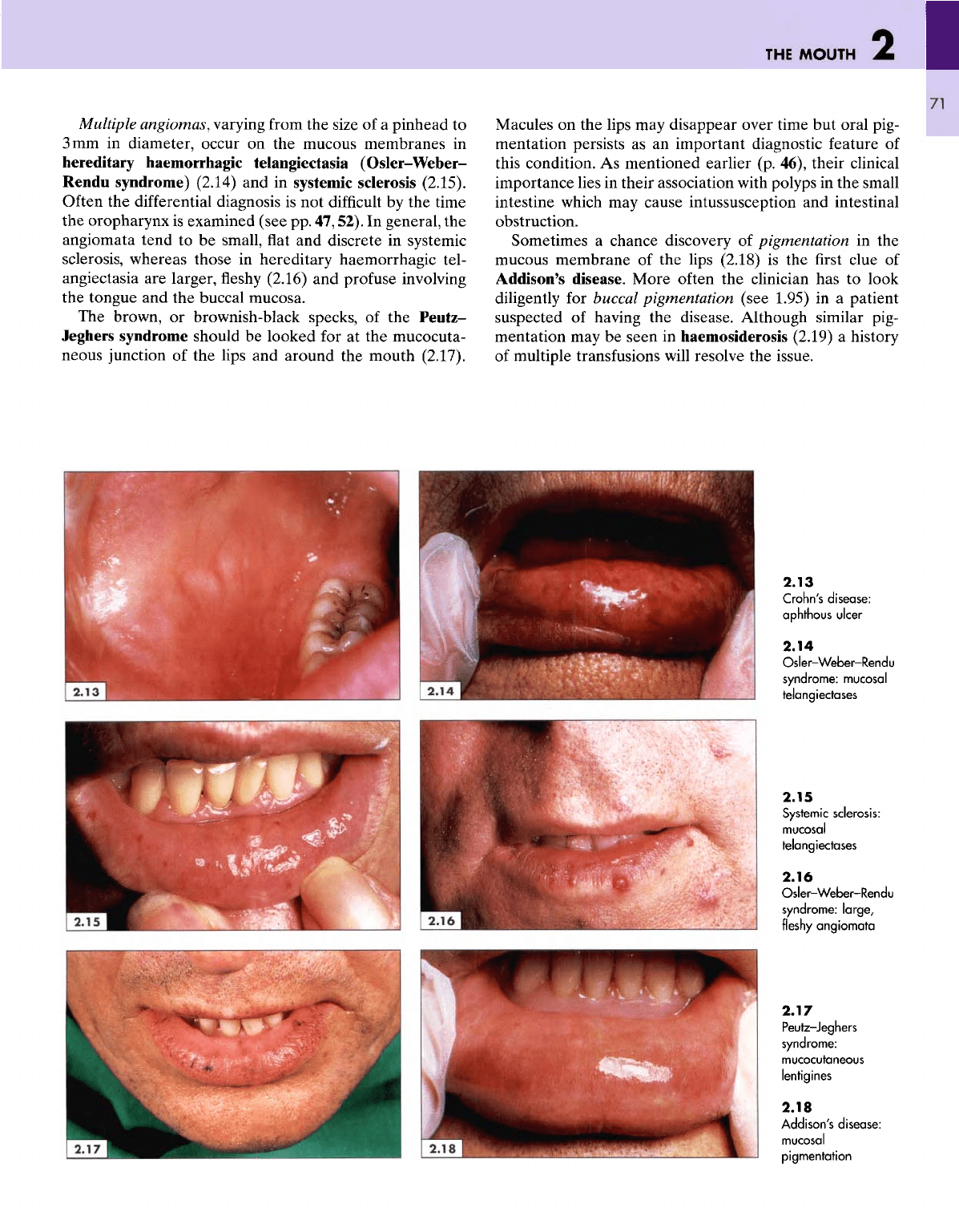
THE
MOUTH
71
Multiple
angiomas,
varying
from
the
size
of a
pinhead
to
3mm in
diameter, occur
on the
mucous membranes
in
hereditary
haemorrhagic
telangiectasia
(Osier-Weber-
Rendu syndrome) (2.14)
and in
systemic sclerosis (2.15).
Often
the
differential
diagnosis
is not
difficult
by the
time
the
oropharynx
is
examined (see
pp.
47,52).
In
general,
the
angiomata
tend
to be
small,
flat and
discrete
in
systemic
sclerosis, whereas those
in
hereditary haemorrhagic tel-
angiectasia
are
larger,
fleshy
(2.16)
and
profuse involving
the
tongue
and the
buccal mucosa.
The
brown,
or
brownish-black specks,
of the
Peutz-
Jeghers syndrome should
be
looked
for at the
mucocuta-
neous junction
of the
lips
and
around
the
mouth (2.17).
Macules
on the
lips
may
disappear over time
but
oral pig-
mentation persists
as an
important diagnostic feature
of
this
condition.
As
mentioned earlier
(p.
46), their clinical
importance lies
in
their association with polyps
in the
small
intestine which
may
cause intussusception
and
intestinal
obstruction.
Sometimes
a
chance discovery
of
pigmentation
in the
mucous membrane
of the
lips
(2.18)
is the first
clue
of
Addison's disease. More often
the
clinician
has to
look
diligently
for
buccal pigmentation (see 1.95)
in a
patient
suspected
of
having
the
disease. Although similar pig-
mentation
may be
seen
in
haemosiderosis (2.19)
a
history
of
multiple transfusions
will
resolve
the
issue.
2.13
Crohn's
disease:
aphthous
ulcer
2.14
Osler-Weber-Rendu
syndrome:
mucosal
telangiectases
2.15
Systemic
sclerosis:
mucosal
telangiectases
2.16
Osler-Weber-Rendu
syndrome:
large,
fleshy
angiomata
2.17
Peutz-Jeghers
syndrome:
mucocutaneous
lentigines
2.18
Addison's
disease:
mucosal
pigmentation
